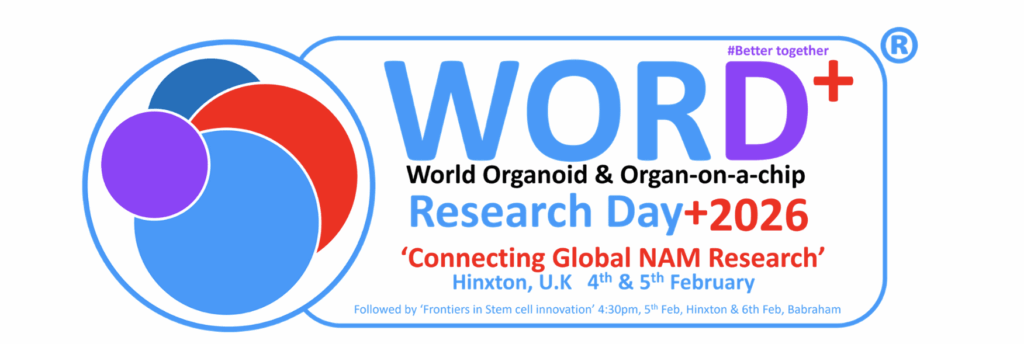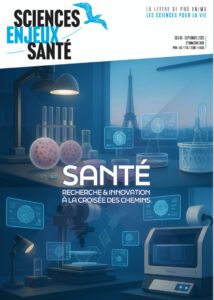
Boosting the AOP Framework with AI, First-ever NAM to be formally qualified by the FDA, InnoZell’s Animal-free quality control, Alternatives to animal-derived products, and more
News on non-animal methods
NOVEMBER 03 - 07, 2025NEWS, REPORTS & POSITION STATEMENTS
1. NC3Rs’ DRIVER recommendations for in vitro research
Research funders like Wellcome Trust and Cancer Research UK (CRUK) are now encouraging the use of the reporting system RIVER – Reporting In Vitro Experiments Responsibly, for in vitro research alongside other National Centre for the Replacement, Refinement and Reduction of Animals in Research (NC3Rs) experimental design and reporting resources.
Based on user testing feedback, the NC3Rs is evolving RIVER into DRIVER – Designing and Reporting In Vitro Experiments Responsibly, and is looking forward to launching the DRIVER recommendations as a dedicated online resource on the NC3Rs website later this year. The DRIVER recommendations go beyond reporting to offer practical guidance on experimental design, helping researchers avoid common pitfalls that can undermine reliability, supporting rigorous, reproducible in vitro science from planning through to publication.
Read more on the NC3Rs website
2. First-ever NAM to be formally qualified by the FDA is imminent
Integral Molecular, a leader in antibody discovery and characterization, announced that its Membrane Proteome Array™ (MPA) used to assess antibody specificity is entering its final stage of FDA ISTAND qualification process to become a Drug Development Tool (DDT).
This follows Integral Molecular’s submission of a Full Qualification Package (FQP) to the FDA. The MPA is a fully validated New Approach Methodology (NAM) that assesses therapeutic antibodies in a human-relevant, cell-based system prior to clinical studies, aligning with the FDA’s vision to accelerate the use of in vitro assays that better predict drug safety.
Read the announcement by Michael Phelan, former lead for this technology and its ISTAND submission
Read more on Integral Molecular website
3. Modelling sex differences of neurological disorders in vitro
Sex effects are observed across mechanisms in common neuropsychiatric and neurodegenerative disorders. Incorporate sex differences into both in vitro and in vivo models will enable researchers to account for the physiological and pathological characteristics of male and female brains, improving the replicability and translatability of research results.
In a recent review, a team led by Dr Antonella Santuccione Chadha discusses in vitro models of increasing complexity used for exploring pathological mechanisms and pharmacological target development. Proposing a roadmap and discussion of best practices, the researchers address the advantages and challenges of using in vitro models to investigate sex differences in neurological disorders, starting with the types of cells used in in vitro models, including immortalized cell lines, primary cultures, induced pluripotent stem cells, up to 3D organoid and organ-on-a-chip models.
Read the review in Nature Reviews Bioengineering
INTERVIEWS, NOMINATIONS & AWARDS
4. NETRI : Finalist for the INPI Trophies in the “Start-up” category
Winner of the DVES Prize 2025 in the “Innovation” category,NETRI was nominated as a finalist for the INPI Trophies in the “Start-up” category. NETRI uses organ-on-a-chip devices to harness the power of neurons to predict the efficacy and safety of treatments, particularly for pain and side effects in oncology.
This year, the INPI Awards jury is chaired by Geoffroy Roux de Bézieux, entrepreneur and investor, former president of MEDEF and the Alliance of French-speaking Employers. Twelve finalists are competing in four categories : Export, Industry, Start-up, and Partnership Research. The INPI is a public body responsible for registering and issuing industrial property titles. Its missions place it at the heart of the creation and innovation process of French companies by facilitating the protection and promotion of their innovations.
Read the interview of NETRI CEO Thibault Honegger
Read more about the INPI 2025 Trophies
5. Roper Toxicology received the Visionary Leadership Award 2025
The Visionary Leadership Awards by SME News have been launched to recognise and celebrate the individuals who are not just responding to change but actively shaping the future of UK business. SME News is a UK-based company that aims to help promote and grow small businesses to the right audience, running a number of yearly awards programmes including its flagship programme UK Enterprise Awards.
This recognition celebrates Roper Toxicology Consulting’s commitment to advancing New Approach Methods (NAMs), promoting the 3Rs, and shaping the future of regulatory toxicology through evidence-based science and collaboration.
TOOLS, PLATFORMS, CALLS
6. JRC call : Boosting the AOP framework with AI
Adverse Outcome Pathways (AOPs) are the maps that make mechanistic toxicology understandable and usable for regulators. Yet, building them remains a time-consuming, largely manual process. A Challenge co-led by the JRC EU Science, Research and Innovation and SCAHT invites bright and creative thinkers to explore how Artificial Intelligence can accelerate AOP development and strengthen the bridge between mechanistic science and regulatory decision-making.
The JRC is looking for curious minds — researchers, students, data scientists, or toxicologists — ready to think outside the box. No rigid protocols, no predefined software : just an open field for exploration, learning, and collaboration. Help shape the smarter toxicology of tomorrow. Registration closes on November 14th, 2025.
INDUSTRY, BIOTECH & PARTNERSHIPS
7. InnoZell : Animal-free quality control on the way to application
The startup InnoZell at the University of Konstanz is developing novel cell-based test systems that are able to detect microbial contaminants in drugs or medical products quickly, sensitively and without animal testing. The new method was developed in the research group of Prof. Dr. Christof Hauck, Professor of Cell Biology at the University of Konstanz. Until now, a large number of animal experiments have been necessary for so-called contamination tests in medicine.
The InnoZell team led by Dr. Clovis Hugues Seumen Tiogang, Dr. Ann-Kathrin Mix and Erik Sontowski from the University of Konstanz and entrepreneur Joachim Plesch is now being funded to the tune of over 800,000 euros as part of the exist Research Transfer Program of the German Federal Ministry for Economic Affairs and Energy (BMWE). The highly competitive program is one of the most important funding schemes for research-based start-up projects in Germany. It supports projects with a high technical development risk in the transition from academic research to commercial implementation. The funding now enables the InnoZell team to further develop its own research results in a targeted manner and prepare the transfer to application.
8. Greenstone Biosciences and Illumina partner to advance precision drug discovery
Greenstone Biosciences, Inc. and Illumina, Inc. announced a collaboration to advance precision drug discovery by combining Greenstone’s extensive induced pluripotent stem cell (iPSC) biobank with Illumina’s state-of-the-art single-cell and spatial genomics technologies. This collaboration aims to generate high-resolution molecular maps that provide unprecedented insights into disease biology and therapeutic response.
Dr. Joseph C. Wu, co-founder of Greenstone Biosciences, stated : “Greenstone has the world’s largest iPSC biobank.This collaboration brings together Illumina’s sequencing power and Greenstone’s iPSC models to illuminate disease mechanisms with unparalleled depth. Together, we aim to redefine how human biology informs drug discovery and development in the future.”
SCIENTIFIC DISCOVERIES & PROTOCOLS
9. Advancing validation of skin-on-chip technology for drug permeation studies
Recent progress in 3D cell culture and microfluidic technology has accelerated the development of organ-on-chip models for preclinical applications. Yet, the lack of standardized, cost-effective platforms that accurately mimic human tissue physiology remains a significant challenge, particularly for drug permeability testing.
A recent study presents a single-compartment skin-on-chip (SoC) model involving 3D co-culture of human dermal fibroblasts and keratinocytes. The microfluidic chip, fabricated via soft lithography, supported dynamic perfusion culture for 11 days. Results confirmed good barrier formation, consistent drug permeability, and mechanical robustness. Unlike previous reports with other SoC devices, this manuscript offers a more extensive approach for high-resolution structural analysis, rheological characterization, and sensitive drug quantification.
Read the publication in Journal of Pharmaceutical and Biomedical Analysis
10. An antibody boosts organoid growth in medical-grade collagen
Refining organoid culturing techniques is essential for their future clinical use. A key challenge has been the reliance on animal-derived matrices such as Basement Membrane Extracts (BME) or Matrigel, which are costly, subject to batch-to-batch variability and non compatible with clinical applications, limiting their translational potential.
The Clevers group has achieved a milestone published in Nature Biotechnology, where the authors show that a single-chain antibody strongly enhances organoid growth in various hydrogels. The antibody sensitizes integrin complexes at the cell surface, enhancing their interaction with surrounding matrix proteins. This enables robust organoid growth in collagen‑1 hydrogels — a substrate that alone is usually insufficient.
Read the announcement by the Hubrecht Institute
Read the publication in Nature Biotechnology
11. Explorative study on alternatives to animal-derived hydrogels
Many in vitro NAM models still depend heavily on matrigel and collagen despite concerns regarding the use of animal-derived materials. As awareness regarding this problem grows, several animal-free extracellular matrix hydrogel alternatives have emerged in the market.
A new publication in Frontiers in Toxicology explores animal-free extracellular matrix hydrogel alternatives for HepaRG liver models, assessing their performance under static and dynamic culture conditions. The study highlighted both the promise and current limitations of these novel matrices for supporting cell health and metabolic competence, and aimed to encourage fellow scientists to join efforts on testing animal-free products in their own experimental setups — a crucial step for achieving ethical, reproducible, and truly human-relevant cell culturing.
12. Human Lung-Chip sets stage for pan-IAV CRISPR RNA therapies
A new collaborative study from the Wyss Institute at Harvard University addressed the challenges of developing antiviral treatments against IAV (Influenza A virus) by simultaneously leveraging a microfluidic “breathing” human lung-alveolus-chip model of IAV infection developed in the group of the founding director, Donald Ingber, and the drug delivery platforms advanced by Associate Director Natalie Artzi, as well as state-of-the-art CRISPR technology.
Studies with this model reveal that the load of the virus in the engineered tissue was reduced by more than 50% after a single administration of the treatment, and the host inflammatory response caused by the virus was significantly blunted. This Lung-Chip model that better mimics human IAV infection than other preclinical models enables the efficacy and safety of CRISPR RNA therapies to be evaluated in a more clinically relevant way than earlier approaches.
Read more on the Wyss Institute website
Read the publication in Lab on a Chip
WORTH (RE)SHARING
Explore NETRI’s Resources Hub
including use cases with OOC (High-content imaging of brain-on-chip microfluidic devices ; Chemotherapy-Induced Peripheral Neuropathy-On-Chip Model ; Traumatic Nerve Injury Platform and more)
UPCOMING WEBINARS, WORKSHOPS, SYMPOSIA
Swedish 3Rs Center’s upcoming webinars on Replacement in research.
Dec. 4 : Human metabolism : combination of in vitro and in silico models
Dec. 11 : Human in vitro models of oral cavity and liver models

Book your ticket for WORD+2026 : 4 — 5 Feb. 2026, Hinxton, Cambridge, U.K


